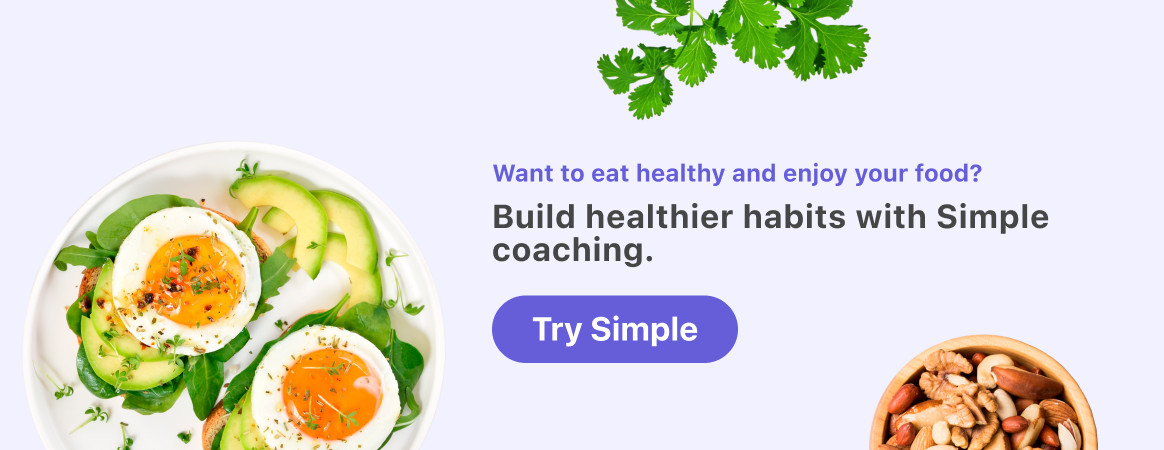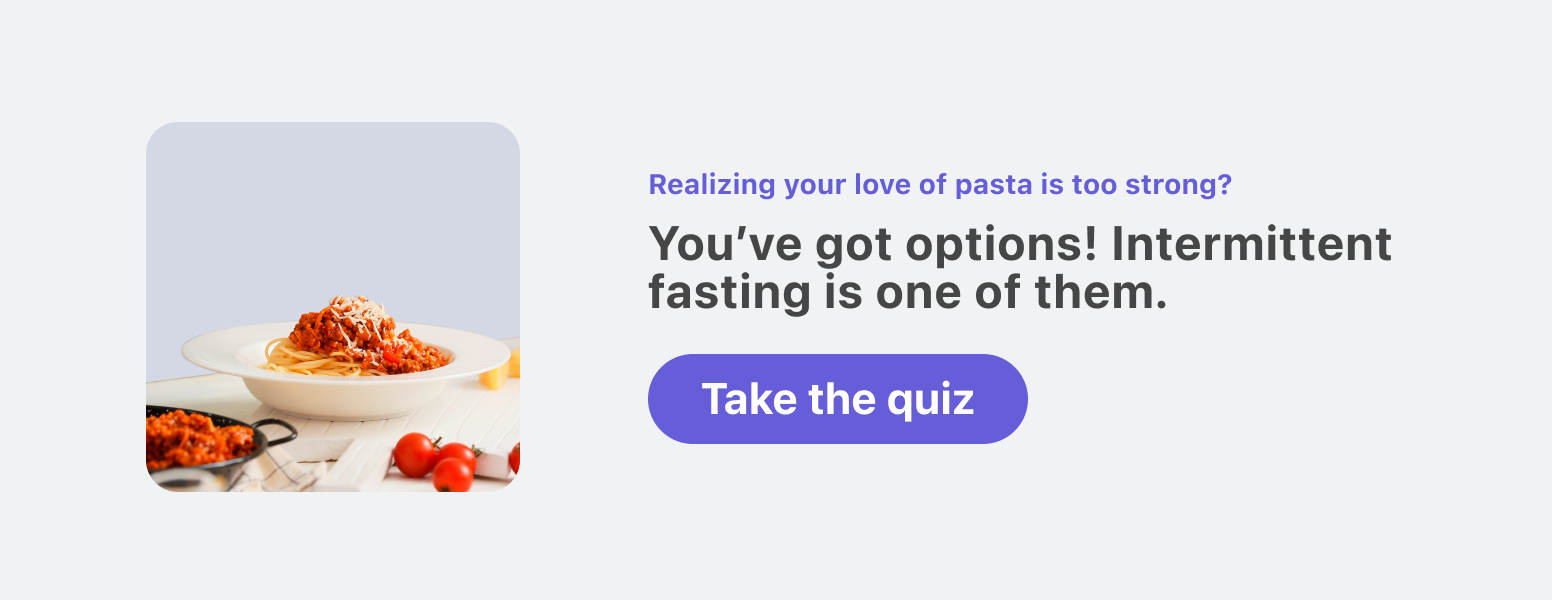The lowdown on the low-carb diet

Low-carbohydrate diets promise weight loss, improved metabolic health, and increased energy levels. But is this all true? Well, sort of.

In this article, we’ll explain how low-carb diets work and help you decide whether this way of eating might be a good fit for you.
Not sure where to begin with your low-carb adventure? Let Simple guide you! Dive into our meal tracker, Nutrition Scores, and delicious recipe ideas. Start by taking our quiz!
What’s a low-carb diet?
There are three main macronutrients:
- protein
- fat
- carbohydrates
We need some protein and fat to survive. But other than fiber, most carbohydrates — including bread, pasta, and rice — are technically not essential.
However, they do play a crucial role in providing energy for the body and can be a part of a healthy diet. And most people feel, function, and perform better with some carbohydrates in their diets.
So, for most people, the goal is to balance their nutrient intake to find the “sweet spot” that works best for them.

General nutrition recommendations
Nutritionists typically express macronutrient needs as either a percentage of total daily calories or as grams per day.
Here are the recommended general nutrient intakes for an average adult eating around 2,000 calories per day.[1]
- Carbohydrates: 45%–65% of daily calories, or around 225–325 g per day, with a daily intake of 2,000 calories.
- Fat: 20%–35% of daily calories, or around 44–77 g per day, with a daily intake of 2,000 calories.
- Protein: 15%–35% of your daily calories, or around 75–175 g per day, with a daily intake of 2,000 calories.
Lower carbohydrate intakes are generally defined as:[2]
- lower carb: around 130 g of carbs per day (less than 26% of total calories)
- very low carb: around 20–50 g of carbohydrates (less than 10% of total calories)
Lower carb, not no carbs
Lower carb — in other words, eating fewer carbs, and ideally higher-fiber, slower-digesting carbs — is not zero carbohydrates, and certainly not “All fruit is dead to me forever!!”
For many people, this type of small change to trim the carbs just a little is ideal: it’s realistic, achievable, and a nice adjustment that improves nutrition quality.
If you’re active, you’ll likely find that you perform and recover better with some carbohydrates in your diet, especially before and after workouts.[3]
Consider carbohydrate quality
What type of carbs you eat may be as important as how much. Improving the quality of your carbohydrate intake tends to help people feel and function better, with plenty of all-day energy and none of the “high and crash” cycles.
As you’ll see in the list below, we recommend eating carbohydrates that are:
- minimally processed (think boiled potatoes instead of potato chips)
- higher in fiber (beans and legumes like lentils and chickpeas, and grains such as quinoa or brown rice are your new best friends)
- slower-digesting (steel-cut oats are a fantastic add-on to any breakfast for sustained energy release to fuel you for the day ahead)
- nutrient-rich (think fruits and vegetables, brown rice, quinoa, buckwheat, etc.)
Should you eat fewer carbs?

There’s no “one size fits all” diet. Let’s look at what could make a lower-carb diet a better fit for you.
Eating fewer carbs might be a good idea if …
You find it hard to stop eating highly processed foods
It’s not you. Highly processed foods, especially those with lots of refined sugar, manufactured fats, and salt, are designed to be “crave-able” and hard to stop eating.[4,5] (Think: chips, candy, cookies, pastries, packaged snacks, and so on.)
These types of foods hijack our brain’s normal appetite, hunger, and fullness (satiety) regulation — rather than being able to eat when we’re physically hungry and stop when we’ve had enough, we feel like we can’t “eat just one.”
By switching to more minimally processed, slower-digesting, higher-fiber carbohydrates, people can enjoy their carbs without the cravings.
You want to lose weight
To lose weight, we have to eat fewer calories than we burn — regardless of the type of diet we choose.
Long term, there’s no difference between low-carb and low-fat diets. Over 1–2 years, people living with obesity or who are overweight can lose the same amount of weight on either one.[6] Again, what matters most is what you can stick to and what will help you consistently eat a little less.
However, because lower-carb diets often help people feel less hungry and more satiated, they’re a good choice for a sustainable weight-loss program.[7]
In particular, this comes from:
- eating fewer highly processed high-carb foods (again, think cake, cookies, chips, candy, and so on)
- eating more minimally processed carbohydrates (think vegetables, fruits, beans and legumes, whole grains, etc.)
- eating more protein and healthy fats on a lower-carb diet (which are more satiating)
You’re trying to manage your blood sugar
Many indicators can tell us about how well you’re managing your blood sugar (aka glycemic control).
For instance, your doctor can measure your average blood sugar level over three months by looking at a blood test measure called HbA1c or A1c.[8] Lowering your overall intake of carbs can help with reducing your A1c if you have either pre- or type 2 diabetes.[9,10]
In everyday life, other indicators that can tell you about your blood sugar control include:
- whether you have big energy “peaks” and “crashes” — or sustained energy throughout the day
- whether you feel uncontrollably “hangry” (hungry + angry), “spaced-out,” or dizzy if you miss a meal — or whether missing a meal is no big deal
Those highs, lows, and “hangries” may be signs of poor blood sugar management. If you’re experiencing these symptoms or considering adopting a low-carb diet, speak with your healthcare provider for more individualized support.
(BTW, if you’re realizing that your love of pasta is too strong and low carb isn’t for you, no worries. You’ve got options! Intermittent fasting is one of them. If you’d like a hand figuring out fasting, take our Simple quiz.)

Risks of a low-carb diet
Low energy
At first, many people find they feel sluggish when they eat fewer carbs. However, over time, most people adapt to a lower intake. With experimentation, you’ll find the carb intake that works for you and your unique needs.
Again, if you’re a highly active person and/or athlete, and you want to experiment with a lower-carb diet, consider getting more guidance from a registered dietitian who can tailor requirements to support your performance and recovery.
Pro tip:
- Try slowly reducing your carbohydrate intake rather than drastically dropping carbs.
- Choose slower-digesting, higher-fiber carbs where possible. These will give you long-lasting energy.
Constipation
Fiber is a non-digestible carbohydrate that regulates your bowel movements and ensures your trip to the bathroom is a comfortable experience. Women need a minimum of 25 g of fiber per day, while men need at least 38 g per day.[11,12]
Eating fewer high-carbohydrate foods may lower your fiber intake, as healthy high-fiber carbs like whole grains, legumes, vegetables, and fruit are important sources of fiber.
Without enough fiber, you may feel bloated and constipated.[13] A lack of fiber also starves your friendly gut bacteria, which adversely affects your digestion.[14]
Pro tips:
- Make friends with lower-carb, higher-fiber foods like vegetables plus nuts and seeds. And include other higher-fiber carbs as you like — think whole grains, beans and legumes, and fruit.
- Stay hydrated to help fiber do its job. If you eat lots of fiber but don’t drink water, it’ll worsen the problem.
- Consider a fiber supplement such as psyllium if you’re still having trouble.
Try tracking your food and water intake using your Simple app to get personalized recommendations for boosting your fiber and hydration.
Disordered eating
A healthy relationship with food always comes first. While seemingly innocent, counting macronutrients may instill a “fear of carbs” and increase your risk for disordered eating.[15]
If you struggle with body image, control around food, or have disordered eating patterns or had them in the past, avoid any major dietary changes and speak with your healthcare provider for professional support.
Pro tip: look for small, self-caring, and mindful changes — think little “nudges” toward health and well-being rather than big overhauls or rigid rules.
Find your low-carb food friends

Want some healthy lower-carb options without a calculator?
Here’s how to choose:
- Look for higher-fiber options. Regardless of the carb content, higher-fiber foods will digest more slowly, give you longer-lasting energy, and keep your blood sugar more balanced.
- Look for less-processed options. For instance, instead of breakfast cereal, try a whole grain like steel-cut oats. Instead of fruit juice or fruit jam, try whole fruit. Instead of white rice or rice noodles, try brown rice. And so on.
- Make vegetables the star wherever possible. When in doubt, go veg! Try a wide variety of colorful vegetables as your side dish, and fill your plate with them.
Vegetables
Look for colorful veggies where possible — the colors signal that they’re high in nutrients and health-promoting substances like antioxidants.
For instance, try veggies like:
- green, leafy vegetables (spinach, kale, arugula, Swiss chard, bok choy, mustard greens, collard greens, alfalfa sprouts)
- cruciferous vegetables (broccoli, cauliflower, Brussels sprouts, cabbage)
- bell peppers
- mushrooms
- eggplant
- carrots
- celery
- okra
- green peas
- summer and winter squashes
- fresh herbs, like basil or parsley
Starchy tubers like potatoes, sweet potatoes, taro, cassava, and yuca often get a bad rap. But these high-carb foods are also high in fiber, and their starch digests fairly slowly.
If you skip the high-calorie toppings like butter or sour cream, you’ll find that these tubers can be filling and satisfying. So, feel free to include them in your menu as well.
Fruit
Explore less sweet fruits, including:
- berries (raspberries, blueberries, blackberries, cranberries)
- rhubarb
- citrus fruits
- apples and pears
- stonefruit like plums or nectarines
Of course, there’s nothing wrong with sweeter fruits like bananas, pineapple, or mango if they’re fresh. These are also high in fiber and nutrients and can be great substitutes for sugary desserts.
Lean proteins
Look for high-protein foods like:
- beef and pork
- poultry, such as chicken or turkey
- wild game, such as elk or venison
- eggs
- high-protein dairy, like Greek yogurt or cottage cheese
- fish
- seafood, such as shrimp, scallops, crab, etc.
- plant-based proteins, such as edamame, tofu, or tempeh
Healthy fats
Look for healthy fats from sources like:
- avocados
- seeds, such as pumpkin, sunflower, chia, hemp, or flax seeds
- nuts, like almonds, walnuts, cashews, pecans, etc.
- nut and seed butters
- coconut
- egg yolks
- olive oil
Whole grains
If you like, incorporate smaller amounts of whole grains, such as:
- steel-cut oats
- brown or wild rice
- quinoa
Beans and legumes
Beans and legumes provide fiber, protein, and slow-digesting, highly satiating carbohydrates. Try options like:
- chickpeas
- black beans
- lentils

Yes, exercise can complement a lower-carb diet. In particular, exercise after a meal (such as a walk after dinner) can help regulate blood sugar and lipid levels.[16]
However, keep in mind that intense workouts may require more carbs for fuel. Adjust your carb intake based on your activity level and energy needs. You may wish to engage in lower-to-moderate types of activities, including walking or strength training, vs. CrossFit or spin classes.
If you’re highly active and/or focused on athletic performance, we recommend consulting with a sports dietitian to ensure you’re meeting all your needs for fueling training and recovery.
For most people, lower-carb diets are safe. Lower-carb diets can work for many people, but individual preferences and needs vary. It’s a good idea to consult with a healthcare professional or dietitian before making significant dietary changes, especially if you have health conditions.
And, again, if you’re highly active, especially in high-intensity or endurance sports, you might find you perform and recover better with more carbs in your diet.
Remember to also focus on the quality of your carb intake, not just the quantity.Looking to navigate the world of quality carbs with confidence? Take the Simple quiz and get delicious, low-carb tips tailored for you.
- Trumbo P, Schlicker S, Yates AA, Poos M. Food and Nutrition Board of the Institute of Medicine, The National Academies. Dietary reference intakes for energy, carbohydrate, fiber, fat, fatty acids, cholesterol, protein and amino acids. J Am Diet Assoc. 2002 Nov;102(11):1621–30.
- Oh R, Gilani B, Uppaluri KR. Low-carbohydrate diet. StatPearls Publishing; 2023.
- Henselmans M, Bjørnsen T, Hedderman R, Vårvik FT. The effect of carbohydrate intake on strength and resistance training performance: A systematic review. Nutrients. 2022 Feb 18;14(4).
- Valicente VM, Peng CH, Pacheco KN, Lin L, Kielb EI, Dawoodani E, et al. Ultraprocessed foods and obesity risk: A critical review of reported mechanisms. Adv Nutr. 2023 Jul 1;14(4):718–38.
- Hall KD. From dearth to excess: The rise of obesity in an ultra-processed food system. Philos Trans R Soc Lond B Biol Sci. 2023 Sep 11;378(1885):20220214.
- Lei L, Huang J, Zhang L, Hong Y, Hui S, Yang J. Effects of low-carbohydrate diets versus low-fat diets on metabolic risk factors in overweight and obese adults: A meta-analysis of randomized controlled trials. Front Nutr. 2022 Aug 9;9:935234.
- Hu T, Yao L, Reynolds K, Niu T, Li S, Whelton P, et al. The effects of a low-carbohydrate diet on appetite: A randomized controlled trial. Nutr Metab Cardiovasc Dis. 2016 Jun;26(6):476–88.
- CDC. All about your A1C [Internet]. Centers for Disease Control and Prevention. 2022 [cited 2023 Aug 30]. Available from: https://www.cdc.gov/diabetes/managing/managing-blood-sugar/a1c.html
- Mayer SB, Jeffreys AS, Olsen MK, McDuffie JR, Feinglos MN, Yancy WS Jr. Two diets with different haemoglobin A1c and antiglycaemic medication effects despite similar weight loss in type 2 diabetes. Diabetes Obes Metab. 2014 Jan;16(1):90–3.
- Dorans KS, Bazzano LA, Qi L, He H, Chen J, Appel LJ, et al. Effects of a low-carbohydrate dietary ntervention on hemoglobin A1c: A randomized clinical trial. JAMA Netw Open. 2022 Oct 3;5(10):e2238645.
- McKeown NM, Fahey GC Jr, Slavin J, van der Kamp JW. Fibre intake for optimal health: How can healthcare professionals support people to reach dietary recommendations? BMJ. 2022 Jul 20;378:e054370.
- Allan S. Recommended daily fibre intake [Internet]. Canadian Digestive Health Foundation. 2022 [cited 2023 Aug 30]. Available from: https://cdhf.ca/en/recommended-daily-fibre-intake/
- Wibisono C, Rowe N, Beavis E, Kepreotes H, Mackie FE, Lawson JA, et al. Ten-year single-center experience of the ketogenic diet: factors influencing efficacy, tolerability, and compliance. J Pediatr. 2015 Apr;166(4):1030–6.e1.
- Seo YS, Lee HB, Kim Y, Park HY. Dietary carbohydrate constituents related to gut dysbiosis and health. Microorganisms. 2020 Mar 18;8(3).
- Cupit C, Redman E. Supporting people to implement a reduced carbohydrate diet: a qualitative study in family practice. BMJ Nutr Prev Health. 2021 May 10;4(1):226–34.
- Arora SK, McFarlane SI. The case for low carbohydrate diets in diabetes management. Nutr Metab . 2005 Jul 14;2:16.
